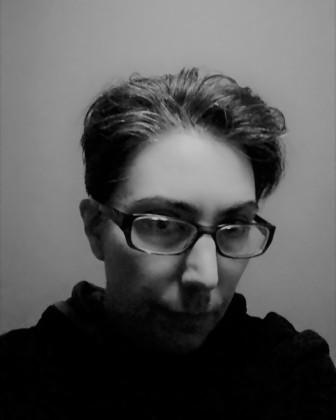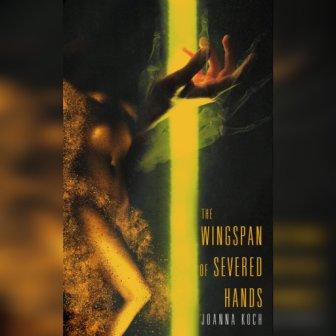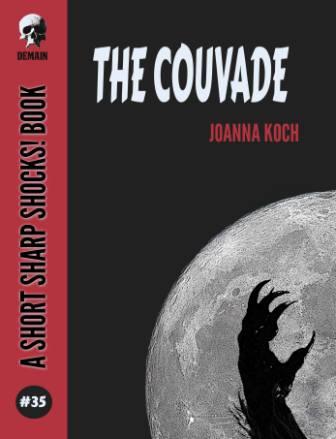Welcome back for this week’s author interview! Today, I’m thrilled to feature Joanna Koch. Joanna is the author of The Wingspan of Severed Hands and The Couvade as well as numerous works of short fiction.
Recently, Joanna and I discussed their latest book as well as their inspiration as an author!
A couple icebreakers to start: when did you decide to become a writer, and who are some of your favorite authors?
 Well, first, thank you so much for having me, Gwendolyn. I admire your work tremendously, and I’m so pleased to speak with you.
Well, first, thank you so much for having me, Gwendolyn. I admire your work tremendously, and I’m so pleased to speak with you.
I started writing around 2010. I’d always done visual art with modest success, though mostly for the pleasure of self-expression. At some point, art wasn’t fulfilling my needs. It wasn’t saying what I wanted to say. I got really into organic and homestead gardening, the physical and stewardship work involved in that. I wrote a gardening blog (which is now defunkt) to document that journey. My first attempted fiction was on the blog: a surreal fairy tale about sawfly larva transforming into roses through compost. I’d never considered writing fiction before. Once I started, I was addicted I guess.
I have such a hard time naming favorite authors, because I appreciate a wide variety, and it changes over time. I’m in my fifties, so I’ve read more books than I can remember. Currently, I’m really interested in Gary Shipley, Kathe Koja, and Gnome’s experimental open source poetry books with pseudonymous authors. I try to stay in touch with popular horror fiction, but I’m more inspired as a writer by work that’s difficult, that feels like it’s just out of my grasp.
Your new book, The Wingspan of Severed Hands, is out now from Weirdpunk Books. What can you share about the inspiration behind it?
The overt source material referenced in the book includes the Grimms fairy tale, “The Maiden Without Hands,” and Robert Chambers’ King In Yellow mythos stories. The personal inspiration was my desire to create a multifaceted character in a richer way than I’d seen in speculative novels like “Ophiuchi Hotline.” I wanted to explore a character with tons of trauma who survives and thrives after going through hell. I wanted that character’s internal world, which is by definition disturbed and uncomfortable to inhabit, to really stain the pages. Professionally, I’ve spent time with people experiencing some levels of psychotic process, and glimpsed the alternate reality created in minds pushed to the extreme. I wanted to capture that, and more than that, suggest it is not a permanent state. I wanted a narrative demonstrating that change is possible.
You’ll pardon me for going on too long, but it’s really a problem that in our society we give up on people once they are labeled with certain diagnoses. There’s no funding for the kind of treatment that really heals deep wounds, the kind of communal support, almost tribal support, that’s proven to effect slow but permanent change. Instead, the focus is on meds and capitalist goals, like putting people into the workplace when what they need is time and space to heal. Anyone who’s interested can look up The Windhorse Project for an example of the kind of non-traditional approach I’m referring to, and look into ecotherapy as well for more radical psychotherapy ideas.
What is it about horror and the weird that appeal to you as a writer and reader?
 At first, I didn’t know I was writing horror. In critiques, I was hearing that my characters behaved shockingly, or subject matter was too distasteful or “unrealistic.” So one day I was reading an anthology of horror for fun, because horror was my go-to “cheap thrill” entertainment. I came across Joyce Carroll Oates. Hers was a kind of horror that wasn’t slasher, that wasn’t necessarily supernatural, and that towed an uncomfortable line between reality and imagination. Full of symbolism and emotion. Unquestionably literature. That’s when I had my “Aha” moment. Horror and the weird can take us places we aren’t allowed to go in normal life. Horror faces hard questions with more courage than therapists, parents, and churches. Horror will not make things easy for you; it’s going to show you the truth. And you feel it, when horror is done well. Rather than letting you sit on the sidelines, horror demands you face moral questions, existential questions, issues of violence and its cause, its meaninglessness; and questions about what you would do to protect those you love or to survive a threat. Horror doesn’t lie, and I love that. That’s the conversation I want to have.
At first, I didn’t know I was writing horror. In critiques, I was hearing that my characters behaved shockingly, or subject matter was too distasteful or “unrealistic.” So one day I was reading an anthology of horror for fun, because horror was my go-to “cheap thrill” entertainment. I came across Joyce Carroll Oates. Hers was a kind of horror that wasn’t slasher, that wasn’t necessarily supernatural, and that towed an uncomfortable line between reality and imagination. Full of symbolism and emotion. Unquestionably literature. That’s when I had my “Aha” moment. Horror and the weird can take us places we aren’t allowed to go in normal life. Horror faces hard questions with more courage than therapists, parents, and churches. Horror will not make things easy for you; it’s going to show you the truth. And you feel it, when horror is done well. Rather than letting you sit on the sidelines, horror demands you face moral questions, existential questions, issues of violence and its cause, its meaninglessness; and questions about what you would do to protect those you love or to survive a threat. Horror doesn’t lie, and I love that. That’s the conversation I want to have.
Your story, “The Revenge of Madeline Usher,” appears in the Stoker-nominated anthology Not All Monsters. How did that particular story come into being?
I love Poe, and I first read all of his work around age 11 or 12 when my mother was cleaning a church for a living. I had to wait around several hours after school for her to finish every day, and it was next to the public library, so I spent that year reading Poe and Shakespeare, and then books like Clockwork Orange and Malone Dies while hanging out in the pews! It was perfect. Anyway, I wanted to examine Poe again from my point of view as a writer, and I was shocked that Madeline literally never speaks in “The Fall of the House of Usher.” In my mind, I remembered a central, vital character. Yet she was a ghost. Worse, she was abused not only in the story, but in the text, in the way Poe handled her. No shade on Poe; he was a product of his time. I was busy with another project, but I had to grab a notebook and write Madeline’s “real” story in her own words right away. It was absolutely urgent. I’m incredibly fortunate it was chosen for Not All Monsters by Sara Tantlinger, who is a delight to work with.
Do you have any particular writing habits? Do you write at a certain time of day or in a certain place? Do you listen to music or prefer the quiet?
 I’m obsessive, and I always need to have a project occupying my mind. I like to have at least one project running as a background program in my head no matter what else I’m doing. When I sit down to write, I tend towards quiet, so I can hear the words, but it depends on the project. I’ve found that different projects, and the desire to push myself to change and experiment, call for different approaches. So I don’t write every day, or at the same time every day. And sometimes I write or edit for ten hours straight. I edit so much. It’s hard to stop! I try to trick myself into creativity by changing things: fonts, location, handwritten versus computer, and now I’m doing a novella on my phone, which makes me laugh, because I think it’s a terrible idea, and that’s exactly why I’m doing it. I’m all about surrealist games. I asked a friend for words by text message all through a piece once, and the results were amazing. I guess I have no rules except to keep writing.
I’m obsessive, and I always need to have a project occupying my mind. I like to have at least one project running as a background program in my head no matter what else I’m doing. When I sit down to write, I tend towards quiet, so I can hear the words, but it depends on the project. I’ve found that different projects, and the desire to push myself to change and experiment, call for different approaches. So I don’t write every day, or at the same time every day. And sometimes I write or edit for ten hours straight. I edit so much. It’s hard to stop! I try to trick myself into creativity by changing things: fonts, location, handwritten versus computer, and now I’m doing a novella on my phone, which makes me laugh, because I think it’s a terrible idea, and that’s exactly why I’m doing it. I’m all about surrealist games. I asked a friend for words by text message all through a piece once, and the results were amazing. I guess I have no rules except to keep writing.
If forced to choose, what is your favorite part of the writing process: establishing setting/mood, crafting characters, or plotting the story?
Mood is essential. By this I mean conceptualizing the tone and texture of the piece, getting a feel for it before any words hit the page. The mood is my guiding light, and setting, characters, and plot are malleable elements that serve it. I take a kind of sculptural approach, although if you press me to explain, I’m not sure how to quantify that. Let’s just say I can work my way through all the mechanics of a piece once I get a strong feeling for it in my gut. If I don’t have that, I move on to another project.
What projects are you currently working on?
As I mentioned, I’m experimenting with writing a novella on my phone. It’s a coming of age story set in the early 80s under the threat of nuclear war and Reagan-era religious politics. I’d like to capture the sense we had that the world was going to end, that there was no reason to plan a future or avoid drugs and sex and violence because we were going to die any second. The bomb was going to drop, or the rapture was going to come. This was also exactly when HIV emerged, and suddenly even in the deep south, queer culture could not be ignored, even though the light shone on it was deeply negative. My narrator is trans, and I’m negotiating how they will or won’t express that in a time and place when almost no one was out, when there was no language for discussing gender identity. My teenage characters are getting in so much trouble. They’re experimenting with a nuclear powered drug that might induce time travel, among other things. I like them all so much, and I’m at the point where I’m really sad I have to start killing them off soon. I’m sure you understand!
Anyway, I also recently tasked myself to write one flash piece every day for a week. I’m often a slow writer, so this was a challenge. It resulted in 5 good pieces, and one has already been accepted for publication. Another I’m going to expand into a novella or mosaic novel because I created a big world with magical beasts and a personal emotional charge that doesn’t fit the short format – very exciting. I have a wealth of material and ideas and simply need the time and energy to craft finished works. I very much do not believe in rushing. I’m planning to release a collection in 2022 or early 2023, even though I have the requisite quantity of material now. I came out in 2020, and it changed my writing. I want more of my new work to be included in my first collection, for both quality and queer representation. If I release nothing but old work, it just won’t be queer enough.
Where can we find you online?
I’m on Twitter @horrorsong. My website is horrorsong.blog where I maintain a running bibliography, including a section with links to my online fiction. My favorite free-to-read piece is “Good Paper,” published by Storgy Magazine Online. There’s also an excerpt of my novella The Wingspan of Severed Hands available at Fright Girl Summer.
Thank you so much for speaking with me. It’s been such a pleasure. Take care!
Big thanks to Joanna Koch for being this week’s featured author!
Happy reading!
